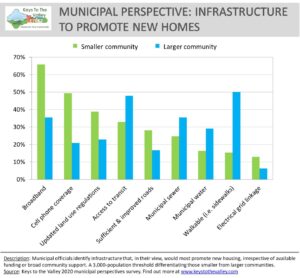Keys to the Valley conducted surveys of residents and public officials in 2020, view the survey methodology here.
Resident perspectives revealed a perceived tradeoff between the need for more homes and the desire to preserve the natural beauty and rural character of the region. Many respondents who live in rural locations indicated a preference for more walkable destinations closer to services. Though rural environments remain popular, when asked what they would look for in a new home, fewer chose to live in rural areas than do currently (Figure 7).

Older and younger residents were somewhat split in their preferences for a new home. Those under age 45 and those with dependents tended to prioritize proximity to work and schools, while those over age 45 prioritized proximity to services and better energy efficiency. Proximity to work was a much higher priority among those living in larger towns and cities. Home size, land characteristics, and building style were high priorities across all age groups and community sizes (Figure 8). See the appendix for additional details on respondents from different size communities and those with dependents.

As noted in the Affordability section, internet access and access to services scored highly as desirable aspects of a new home for residents from both smaller and larger communities. This importance of internet was rated higher from smaller community municipal officials (top 3 priority for 66%), than larger (35%). As Figure 9 shows, other infrastructure priorities vary considerably among municipal officials of different size communities. Smaller communities rated cell coverage (49%) as a top priority while larger communities rated walkability (50%) and transit access (48%) as a top priority. Transit access was also highlighted by providers of homes with supportive services as essential for meeting the needs of vulnerable populations. See the Emergency Housing and Homes with Supportive Services for more detail.

Of municipal officials from the larger communities, 75% believe there is public support for infrastructure improvements whereas only around 25% of municipal officials from smaller communities do. Municipal officials generally agree that improving sidewalks is more likely to garner support than initiatives such as expanding public water wastewater, or transit systems (Figure 10). These results highlight both the interest and challenges faced when looking to improve infrastructure for our region’s home. Seeking a balance of desired infrastructure improvements and fiscal sustainability will be critical for communities. Local officials should incorporate public opinion and feedback at all stages of infrastructure planning, while also seeking opportunities to educate the public on the benefits to the community of potential infrastructure improvements.

In your own words…
- “I would select Broadband twice if I could”
- “quiet and privacy with plenty of the natural world incorporated into the design”
- “Village area with more distance from neighbors’ properties”
- “Similar to where I live now. Very close to shopping, parks, rail trail. Sidewalk access, buses, etc.”
- “Low-cost financing options other than reliance on state & federal programs; more flexibility in state regulations for housing development.”
From smaller communities
- “All the improvements require capital expenditures and residents have always been concerned about increasing taxes.”
- “Utilize empty high school”
- “We don’t really have an underdevelopment problem so much as an under population problem.”
From larger communities
- “Providing incentives for more businesses to improve local economy and add local jobs.”
- “The key areas require a Town/corporate/non-profit partnership.”
- Staff would support modification of zoning to enhance housing development but community is not necessarily supportive of more housing

